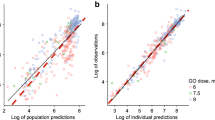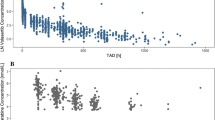Abstract
Background and objective
The pharmacokinetics of darbepoetin alfa after intravenous (IV) administration in the oncology setting have not been previously reported. The objective of this study was to evaluate the pharmacokinetics of IV or subcutaneous (SC) darbepoetin alfa in patients with non-myeloid malignancies undergoing multicycle chemotherapy.
Methods
Fifty-six patients (haemoglobin <13.0 g/dL) received weekly darbepoetin alfa 2.25 µg/kg administered either IV (n = 27) or SC (n = 29) during up to three cycles of chemotherapy. Noncompartmental pharmacokinetic analysis was performed, including analysis of intensive pharmacokinetic profiles collected over 168 hours during week 1 of both the first and third cycles of chemotherapy.
Results
Darbepoetin alfa serum concentrations exhibited a biphasic profile (a rapid distributive phase followed by a slower terminal elimination phase) after IV administration, whereas darbepoetin alfa was slowly absorbed after SC administration. Darbepoetin alfa exhibited limited extravascular distribution after IV administration, with both initial and steady-state mean volumes of distribution (36.1 mL/kg and 55.2 mL/kg, respectively, after a single IV dose) approximating the plasma volume. After a single IV dose, darbepoetin alfa exhibited a mean clearance of 1.05 mL/h/kg, with a mean terminal half-life of 38.8 hours. Similar pharmacokinetic results were observed after single and multiple doses of darbepoetin alfa, for both SC and IV administration.
Conclusion
Darbepoetin alfa is cleared slowly after IV administration to patients with cancer receiving chemotherapy, resulting in a terminal half-life of 38.8 hours. No evidence of accumulation and no changes in pharmacokinetic profiles after repeated administration were observed in cancer patients undergoing cyclic chemotherapy, for both IV and SC dosing.








Similar content being viewed by others
Notes
The use of trade names is for product identification purposes only and does not imply endorsement.
References
Groopman JE, Itri LM. Chemotherapy-induced anemia in adults: incidence and treatment. J Natl Cancer Inst 1999 Oct 6; 91(19): 1616–34
Koury MJ, Bondurant MC. Control of red cell production: the roles of programmed cell death (apoptosis) and erythropoietin. Transfusion 1990; 30: 673–4
Ludwig H, Pecherstorfer M, Leitgeb C, et al. Recombinant human erythropoietin for the treatment of chronic anemia in multiple myeloma and squamous cell carcinoma. Stem Cells 1993; 11: 348–55
Beguin Y. Prediction of response to optimize outcome of treatment with erythropoietin. Semin Oncol 1998 Jun; 25 (3 Suppl. 7): 27–34
Miller CB, Jones RJ, Piantadosi S, et al. Decreased erythropoietin response in patients with the anemia of cancer. N Engl J Med 1990 Jun 14; 322: 1689–92
Curt GA. Impact of fatigue on quality of life in oncology patients. Semin Hematol 2000; 37 Suppl. 6: 14–7
Walker RH. Special report: transfusion risks. Am J Clin Pathol 1987; 88: 374–8
Goodnough LT, Brecher ME, Kanter MH, et al. Transfusion medicine: first of two parts: blood transfusion. N Engl J Med 1999 Feb 11; 340: 438–47
Elliott S, Lorenzini T, Asher S, et al. Enhancement of therapeutic protein in vivo activities through glycoengineering. Nat Biotechnol 2003; 21: 414–21
Glaspy J, Jadeja JS, Justice G, et al. Darbepoetin alfa given every 1 or 2 weeks alleviates anaemia associated with cancer chemotherapy. Br J Cancer 2002; 87: 268–76
Glaspy J, Tchekmedyian NS. Darbepoetin alfa administered every 2 weeks alleviates anemia in cancer patients receiving chemotherapy. Oncology (Huntingt) 2002; 16 (10 Suppl. 12): 23–9
Kotasek D, Steger G, Faught W, et al. Darbepoetin alfa administered every 3 weeks alleviates anaemia in patients with solid tumours receiving chemotherapy; results of a double-blind, placebo-controlled, randomized study. Eur J Cancer 2003; 39: 2026–34
Hedenus M, Adriansson M, San Miguel J, et al. Efficacy and safety of darbepoetin alfa in anaemic patients with lymphoproliferative malignancies: a randomized, double-blind, placebocontrolled study. Br J Haematol 2003; 122: 394–403
Vansteenkiste J, Pirker R, Massuti B, et al. Double-blind, placebo-controlled, randomized phase 3 trial of darbepoetin alfa in lung cancer patients receiving chemotherapy. J Natl Cancer Inst 2002 Aug 21; 94(16): 1211–20
Cases A. Darbepoetin alfa: a novel erythropoiesis-stimulating protein. Drugs Today (Barc) 2003 Jul; 39(7): 477–95
Abels RI. Use of recombinant human erythropoietin in the treatment of anemia in patients who have cancer. Semin Oncol 1992 Jun; 19 (3 Suppl. 8): 29–35
Platanias LC, Miller CB, Mick R, et al. Treatment of chemotherapy-induced anemia with recombinant human erythropoietin in cancer patients. J Clin Oncol 1991; 9: 2021–6
Oberhoff C, Neri B, Amadori D, et al. Recombinant human erythropoietin in the treatment of chemotherapy-induced anemia and prevention of transfusion requirement associated with solid tumors: a randomized, controlled study. Ann Oncol 1998; 9: 255–60
Macdougall I, Gray SJ, Elston O, et al. Pharmacokinetics of novel erythropoiesis stimulating protein compared with epoetin alfa in dialysis patients. J Am Soc Nephral 1999; 10: 2392–5
Allon M, Kleinman K, Walczyk M, et al. Pharmacokinetics and pharmacodynamics of darbepoetin alfa and epoetin in patients undergoing dialysis. Clin Pharmacol Ther 2002; 72(5): 546–55
Egrie JC, Dwyer E, Lykos M, et al. Novel erythropoiesis stimulating protein (NESP) has a longer serum half-life and greater in vivo biological activity than recombinant human erythropoietin (rHuEPO). Blood 1997; 90: 56–7a
Egrie JC, Dwyer E, Browne JK, et al. Darbepoetin alfa has a longer circulating half-life and greater in vivo potency than recombinant human erythropoietin. Exp Hematol 2003 Apr; 31(4): 290–9
Glaspy J, Colowick AB, Heatherington A, et al. Novel erythropoiesis stimulating protein (NESP) exhibits a prolonged serum half-life (T1/2) in oncology patients (Pts). Proc Am Soc Clin Oncol 2000; 19: 54a
Sawabe Y, Takiguchi Y, Kikuno K, et al. Changes in levels of serum erythropoietin, serum iron and unsaturated iron binding capacity during chemotherapy for lung cancer. Jpn J Clin Oncol 1998; 28: 182–6
Dunphy FR, Harrison BR, Dunleavy TL, et al. Erythropoietin reduces anemia and transfusions: a randomized trial with or without erythropoietin during chemotherapy. Cancer 1999; 86: 1362–7
Heatherington AC, Schuller J, Mercer AJ. Pharmacokinetics of novel erythropoiesis stimulating protein (NESP) in cancer patients: preliminary report. Br J Cancer 2001; 84 Suppl. 1: 11–6
Elliott S, Lorenzini T, Chang D, et al. Fine-structure epitope mapping of antierythropoietin monoclonal antibodies reveals a model of recombinant human erythropoietin structure. Blood 1996; 87: 2702–13
Elliott S, Chang D, Delorme E, et al. Isolation and characterization of conformation sensitive antierythropoietin monoclonal antibodies: effect of disulfide bonds and carbohydrate on recombinant human erythropoietin structure. Blood 1996; 87: 2714–22
Glaspy J, Henry D, Patel R, et al. Effects of chemotherapy on endogenous erythropoietin levels and the pharmacokinetics and erythropoietic response of darbepoetin alfa: a randomised clinical trial of synchronous versus asynchronous dosing of darbepoetin alfa. Eur J Cancer 2005 May; 41(8): 1140–9. Epub 2005 Apr 8
Piroso E, Erslev AJ, Caro J. Inappropriate increase in erythropoietin titers during chemotherapy. Am J Hematol 1999; 32: 248–54
Jelkmann W. The enigma of the metabolic fate of circulating erythropoietin (Epo) in view of the pharmacokinetics of the recombinant drugs rhEpo and NESP. Eur J Haematol 2002; 69(5-6): 265–74
Chapel S, Veng-Pedersen P, Hohl RJ, et al. Changes in erythropoietin pharmacokinetics following busulfan-induced bone marrow ablation in sheep: evidence for bone marrow as a major erythropoietin elimination pathway. J Pharmacol Exp Ther 2001; 298(2): 820–4
Acknowledgements
This study was supported by Amgen Inc., Thousand Oaks, CA, USA. We thank the Darbepoetin Alfa 990146 Study Group as well as the research nurses and the patients who participated in this study. Andrew J. Mercer, PhD, managed the study; Nelson Jumbe, PhD, and Robert Rovetti assisted with the pharmacokinetic analyses and Jose Rodriguez assisted with the bioanalytical analyses. Helen M. Wilfehrt, PhD, Graham Jang, PhD, Balaji Agoram, PhD, and Alexander Liede, PhD, assisted with the writing of this manuscript.
In addition to Drs Dittrich and Schueller, the Darbepoetin Alfa 990146 study group included the following physicians: L. Bertoli (USA), J.Y. Blay (France), R. Delva (France), J.Y. Genot (France), A. Haynes (UK), P. Johnston (UK), T. Lesimple (France), T. Mughal (UK), and C.J. van Groeningen (The Netherlands).
Drs Rossi and Sullivan are employees of Amgen Inc. and are stockholders. Dr Heatherington was an employee of Amgen Inc. at the time the study was conducted. Drs Schueller and Dittrich were investigators on the trial.
Author information
Authors and Affiliations
Corresponding author
Rights and permissions
About this article
Cite this article
Heatherington, A.C., Dittrich, C., Sullivan, J.T. et al. Pharmacokinetics of Darbepoetin Alfa after Intravenous or Subcutaneous Administration in Patients with Non-myeloid Malignancies Undergoing Chemotherapy. Clin Pharmacokinet 45, 199–211 (2006). https://doi.org/10.2165/00003088-200645020-00005
Published:
Issue Date:
DOI: https://doi.org/10.2165/00003088-200645020-00005




